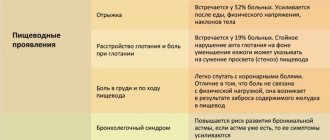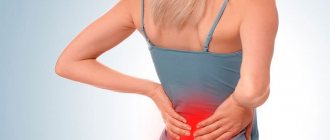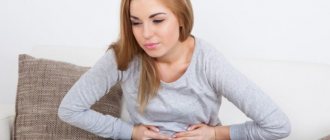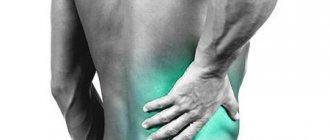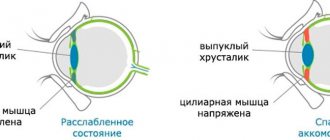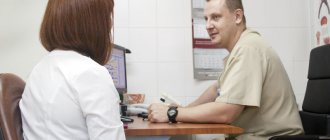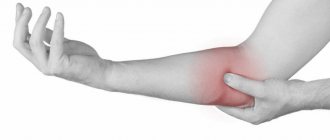Damage to the gastrointestinal tract (GIT) causes abdominal pain in the navel area. This serious signal often indicates diseases of the small intestine. Impaired functioning of the organ causes inadequate absorption of nutrients and vitamins, which affects the condition and appearance of the person.
With such an alarming symptom, a visit to the doctor cannot be postponed, since pain in the navel area also appears due to cancerous formations in the small intestine. And everyone understands how life-threatening this condition is.
What can hurt there?
Patients who turn to gastroenterologists with a complaint of soreness in the peri-umbilical area are diagnosed with the following diseases of the small intestine:
- Irritable bowel syndrome
(IBS), additional symptoms - bloating, cramps, flatulence, constipation, “sheep” or loose stools, a feeling of incomplete bowel movement after defecation. Attentive patients also name back pain, anxiety, and depression, among other symptoms. - Enterocolitis
(inflammation in the small intestine). In addition to the characteristic gastrointestinal disorders with diarrhea, bloating after eating, nausea, and lack of appetite. In the acute form, symptoms of intoxication, elevated temperature, and coating on the tongue are additionally noted, and in the chronic form, a decrease in body weight. - Intestinal obstruction
(occurs due to adhesions, neoplasm or hernia). - Cancer
(a malignant tumor is determined by local symptoms, dyspeptic disorders and spastic pain around the navel). - Intestinal ischemia
(circulatory disorders due to damage to the mesenteric vessels). - Enzyme deficiency
(enzyme deficiency leads to dyspepsia, when a person suffers from heartburn, belching, constipation or diarrhea). There is also chronic obesity, gastrointestinal infections, stomach colic - felt in the upper left side. - Umbilical hernia
(the main symptom is swelling near the navel; pregnancy is a common cause of protrusion). Pain, constipation and nausea appear in the later stages of the disease. - Jeunitis
(inflammation is accompanied by a number of disorders - motility, digestion and absorption of food, as well as excessive development of pathogenic microflora).
Treatment
Help before diagnosis
Functional dyspeptic disorders can be successfully corrected by changing diet and lifestyle. If pain at the navel is combined with loose stools, you need to temporarily eliminate dairy products, fatty foods, and dishes with artificial sweeteners. The diet should consist of grain crops, stewed or boiled vegetables, lean meat and fish in moderation. It is important to avoid stressful activities.
If there are signs of food poisoning, first aid includes gastric lavage, if you have recently consumed low-quality food, and taking sorbents. It is necessary to drink more liquid (water, unsweetened dried fruit compote) to prevent dehydration of the body. With severe umbilical spasms and a sharp deterioration in health, the patient needs emergency medical care.
Conservative therapy
The treatment regimen is selected after identifying the root cause of peri-umbilical pain syndrome. Treatment is mainly carried out on an outpatient basis. Hospitalization is required for exacerbation of a chronic disease, a possible acute surgical condition, or severe dehydration. In gastroenterology, the following groups of drugs are used for pain in the peri-umbilical region:
- Enzymes
. Preparations of pancreatic enzymes improve digestion processes, eliminate the phenomena of malabsorption, due to which the pain syndrome disappears. For some combined pathologies of the intestines and stomach, in addition to enzymes, gastric juice is recommended. - Antispasmodics
. Most episodes of pain in the navel area are associated with spastic contractions of the intestines, which are successfully relieved by drugs with antispasmodic effects. For severe pain, analgesics are taken. - Probiotics
. Medicines normalize intestinal microflora and prevent bacterial overgrowth syndrome (SIBO). They are effective for a combination of pain and dyspeptic symptoms. To enhance the effect of probiotics, they are supplemented with prebiotics. - Antidiarrheal drugs
. For chronic diarrhea that is not corrected with diet, medications of the loperamide group are prescribed. They normalize gastrointestinal motility, slow down the movement of feces, and eliminate excessive peristaltic contractions and associated pain in the abdominal area.
The doctor selects a balanced diet that must be followed to prevent exacerbations of the disease. During the period of remission of chronic diseases, drinking mineral waters, physiotherapy methods, and sanatorium-resort treatment are recommended. In case of severe functional disorders of the gastrointestinal tract, it is advisable to conduct psychotherapy, which is aimed at eliminating the effects of stress factors.
Surgery
Pain in the navel area can be caused by surgical pathologies (appendicitis, intestinal obstruction), for which urgent surgical treatment is indicated. For uncomplicated forms of diseases in abdominal surgery, laparoscopic surgical techniques are used. Small intestinal obstruction and destructive forms of appendicitis require open surgery by laparotomy.
For hernias, various methods of hernioplasty are performed using mesh allografts and the patient’s own tissue to close the umbilical ring defect. Treatment of oncological processes involves an extended operation with resection of a section of the intestine and surrounding tissues as a single block, after which an intestinal anastomosis is formed or an enterostomy is removed.
Pain to the right of the navel
This symptom is considered characteristic of an umbilical hernia, intestinal obstruction and inflammatory diseases of the organ, when a person suffers from cramping attacks. Other causes of discomfort on the right side of the navel are described in the table below.
| Diagnosis | Additional symptoms |
| Stomach ulcer (provokers – fatty or spicy foods, alcohol) | No appetite |
| Binge eating | Abdominal distension and constipation |
| Sick liver | Physical suffering is aching in nature |
| Stones in the gallbladder or ducts - severe acute pain to the right of the navel occurs periodically in attacks | Nausea, vomiting |
| Pancreatic damage | Pancreatitis is accompanied by pain above the navel in the center; cancer does not manifest itself at the initial stage |
| Appendicitis | Abdominal muscle tension |
| Pathological condition of the kidneys | Backache |
| Diverticulitis (bumps in the small intestine) – determined by a doctor by palpation | Vomit with an unpleasant odor, alternating constipation with diarrhea, fever, nausea, temperature, and sometimes blood in the stool |
Other reasons that apply only to women are the following:
- Menstrual cycle (an unpleasant symptom appears three days before the start of menstruation).
- Ectopic pregnancy.
- Inflammation in the reproductive organs.
Pain in the right side at the level of the navel (if it radiates to the back or leg) is a signal of problems in the right kidney
, gallbladder with ducts or pancreas. Duodenal ulcer and duodenitis are also diagnosed with this symptom. The appearance of painful sensations in this area immediately after eating indicates problems with the stomach.
What medications can be prescribed?
To eliminate the unpleasant symptoms of pain in the navel area, the doctor may prescribe the following medications:
Intended for the treatment and prevention of spasms of smooth muscles of internal organs (biliary and intestinal colic, biliary dyskinesia, cholecystitis), spastic constipation, exacerbations of peptic ulcers, tenesmus.
Contraindicated in case of hypersensitivity, high blood pressure, cardiogenic shock, severe renal and liver failure.
Price – from 50 to 230 rubles.
It is used for the symptomatic treatment of mild or moderate pain syndrome due to stomach or intestinal colic, as well as other diseases associated with spasms of smooth muscles.
Contraindicated in cases of hypersensitivity, obstruction in the gastrointestinal tract, collaptoid conditions, diseases of the circulatory system, tachyarrhythmia, decompensated heart failure, functional disorders of the kidneys or liver, and angle-closure glaucoma.
Price – from 120 to 355 rubles.
An antispasmodic drug intended to reduce smooth muscle tone. It is used to relieve spasms of any smooth muscle organ in the gastrointestinal tract, as well as during attacks of cholelithiasis, cholecystitis, renal colic, and increased uterine tone during pregnancy.
Contraindicated in case of hypersensitivity, children under 6 months of age. and the elderly, with glaucoma and acute renal failure, with problems with atrioventricular conduction, and comatose patients.
Price – from 9 to 91 rubles.
An antacid drug with a pronounced acid-neutralizing, enveloping and adsorbing effect. Intended for the treatment of gastritis, enterocolitis, peptic ulcer, acute duodenitis, mucosal erosions in the gastrointestinal tract, diverticulitis, pancreatitis, colopathy, proctitis, sigmoiditis, poisoning, heartburn, and damage to the digestive system after taking medications and aggressive compounds.
Contraindicated in hypersensitivity, hypophosphatemia, chronic renal failure and Alzheimer's disease.
Price – from 170 to 380 rubles.
An effective adsorbent used to treat gastrointestinal disorders and eliminate associated pain, namely infectious, chronic and acute diarrhea, dyspepsia, heartburn and bloating.
Contraindicated in case of intestinal obstruction, isomaltase-sucrase deficiency, glucose intolerance or impaired absorption of glucose-galactose, as well as intolerance to the drug.
Price – from 160 to 350 rubles.
A remedy for reducing flatulence. It is used for flatulence, dyspepsia, Roemheld's syndrome, as well as for certain types of diagnostics of the abdominal organs.
Contraindicated in case of hypersensitivity to the drug.
Price – from 280 to 450 rubles.
Pain to the left of the navel
This part of the abdomen contains the intestines, spleen, ureter, kidney, body and tail of the pancreas, fallopian tube with ovary. Functional disorders of these organs cause suffering, which is expressed by acute, chronic, paroxysmal, cutting or stabbing pain to the left of the navel.
Intestinal diseases are diagnosed (diverticulitis, obstruction, hernia, IBS, cancer, gastric volvulus, food poisoning) and several other conditions:
- Ovarian cyst (pain extends to thighs).
- Constipation (accompanied by bloating and weight loss).
- Crohn's disease.
- Ectopic pregnancy (sharp pain on the left side of the lower abdomen, bleeding from the vagina, dizziness).
- Endometriosis.
- Infection in the kidneys (additional symptoms are poor appetite, weight loss, swelling of the lower left abdomen, sweating).
- Volvulus of the sigmoid colon.
- Diarrhea (cramping, cramping pain, loud sounds in the intestines).
- Abdominal aortic aneurysms (pallor of the skin, drop in blood pressure).
- Kidney stones (vomiting, girdle pain spreading throughout the abdomen or from the lower back to the groin, in men - to the penis).
- Pneumonia (cough with brown or yellow sputum, fever).
- Pancreatic cancer (weight loss, jaundice, no appetite).
Pain above the navel
The stomach and duodenum are located in the upper abdomen. Damage to these organs, as well as overeating, fatty and heavy foods cause pain above the navel
.
| Diagnosis | Additional symptoms |
| Acute gastritis | Nausea, diarrhea, vomiting, gray coating on the tongue, lethargy |
| Inflammatory process in the appendix at the initial stage | Suffering is caused by sudden movements and walking at a fast pace, during which the pain intensifies |
| Stomach cancer | Feeling of fullness in the left side, aversion to food, sudden weight loss, apathy |
| Pancreatitis (inflammation of the body of the pancreas) | Diarrhea, abnormal digestion of food (bloating, flatulence), stool with mucus |
| Duodenitis | Heaviness in the stomach after eating, severe pain occurs when pressing in the epigastric region |
| Gastroduodenitis | A cramping, pulsating pain syndrome radiates to the right side. Accompanied by bloating and nausea. |
| Ulcer of the duodenum and stomach | Heartburn, weight loss, lightheadedness |
What accompanying symptoms accompany pain?
Abdominal pain near the navel can be caused by spasm or stretching of hollow formations (stomach, gall bladder, intestines), signals from the capsule of parenchymal organs. In differential diagnosis, pain is considered in conjunction with other manifestations. We will present the most common pathology with typical symptoms.
Acute gastroenteritis
The body reacts with inflammation of the stomach and intestines to food poisoning, infection with pathogens of dysentery, cholera, salmonella, and a pathogenic strain of E. coli. Enteritis as an isolated lesion of the small intestine is rare.
For example, with helminthic infestation, after surgical interventions on the abdominal organs. Therefore, the course of enteritis begins with epigastric pain, repeated vomiting, dizziness, weakness, then persistent diarrhea (possibly with blood), pain around the navel.
When symptoms appear in several people who have eaten the same dishes, it is most likely to assume a foodborne illness. At home, you need to give enterosorbents to drink (activated carbon, Enterosgel, Smecta), drinking plenty of slightly acidified water is recommended.
If more than an hour has passed after eating, then there is no point in rinsing the stomach. To examine a doctor, you must call an ambulance.
Attack of acute appendicitis
The vermiform appendix is located in the initial part of the large intestine. Most people know to be wary of pain in the right iliac fossa. However, the anatomy of the appendix allows it to deviate significantly, “go” into the hypochondrium to the right, into the small pelvis and towards the center. Therefore, if your stomach hurts in the navel area, doctors try to confirm or rule out appendicitis.
The most characteristic signs:
- sudden onset with pain in the epigastric region;
- vomit;
- nausea;
- rise in temperature;
- weakness;
- after a few hours, the localization of pain moves to the navel or iliac region on the right, increasing in intensity;
- bloating;
- constipation;
- increased in position on the left side;
- positive symptoms of inflammation of the peritoneal layers.
Let us remind you what should not be done in such cases. It is strictly forbidden to: rinse the stomach and induce vomiting using home methods, apply a heating pad, or take general painkillers based on analgin.
These actions blur the symptoms and make diagnosis difficult. Warming up increases inflammation and brings the gangrenous form of the disease closer. The main measure is to quickly call an ambulance.
If the diagnosis of appendicitis is confirmed, treatment is only surgical
Umbilical hernia
More often detected in infants. The expansion of the muscle ring is associated with weakness and underdevelopment. In adults, formation is possible due to weakening of the muscular wall of the peritoneum, high pressure in the abdominal cavity and an enlarged abdomen (pregnancy, ascites with cardiac decompensation, cirrhosis of the liver, long-term hard work, previous surgery).
Why does my stomach hurt after lifting weights?
The protrusion under the skin is noticeable; a soft hernial sac is identified by palpation, which is reduced in the supine position when relaxed.
Severe pain occurs when pinched, when contracted muscles do not allow the contents of the sac to be reduced. Possible vomiting, flatulence, constipation. When part of the intestine is strangulated, the clinical picture of acute intestinal obstruction develops.
In most children, symptoms disappear by age three or earlier. Pediatricians recommend wearing a special bandage or patch. If strangulation develops, urgent surgical assistance is required.
The muscle ring is dissected, the condition of the intestines and mesentery located in the hernial sac is examined (if signs of necrosis appear, the damaged area must be removed), the hernia is reduced and the hole is sutured with plastic surgery of the abdominal wall.
Sign of dysbacteriosis
After long-term treatment with antibacterial drugs for various reasons, the balance of intestinal bacteria in a person is disrupted. This is manifested by pain in the intestines and diarrhea. Adults tolerate symptoms satisfactorily and can gradually restore the composition of the flora on their own. Children feel much worse.
The right solution is to take a course of probiotics and prebiotics. These are special products containing the necessary bifidobacteria and lactobacilli, as well as preparations to activate and support their growth.
When purchasing fermented milk products declared as “Biokefir”, we recommend paying attention to the production time. Bifidobacteria persist only in the first 2–3 days; subsequently, the product has no medicinal properties, retaining only its taste.
Crohn's disease
The appearance of periodic attacks of pain along the intestines in a teenager should raise suspicion of Crohn's disease. The peak incidence occurs between the ages of 12 and 18 years.
The entire digestive tract can be affected by Crohn's disease.
At the same time, the patient may experience bloody diarrhea caused by ulcers and cracks in the intestinal wall, bloating, and joint pain. Boys are more often affected. The child needs to be examined. Treatment is prescribed by a gastroenterologist.
Diverticulitis
Diverticula are saccular formations from a thinned intestinal wall. Their length varies from 5 mm to 15 cm. When they occur in the thin part, they give pain in the navel area. An infection gets into the diverticulum and causes inflammation.
The patient's temperature rises and signs of intoxication appear (nausea, headache). Formations do not disappear on their own. Inflammation is treated with antimicrobial agents, and if necessary, surgically.
Abdominal migraine
The name “abdominal” was given to migraine by analogy with headaches. The idea of local vasospasm is already a thing of the past. It has been established that both spastic and vasodilatory effects in certain areas are equivalent. The intestines are fed by arteries passing through the mesentery. Disruption of blood flow occurs due to spasm or delay of blood flow in arteries that have lost their tone.
The disease manifests itself as attacks of pain around the navel, lasting 30–40 minutes. It is detected in people at any age. It can begin in teenagers, which is associated with hormonal changes. Hereditary predisposition influences.
At the same time, the person feels nausea, diarrhea, and vomiting. People are more susceptible to emotional, nervous type, intensely experiencing stressful situations, overloaded with work. Treatment requires the intervention of a neurologist or psychologist.
Pain under the belly button
Women's lower abdomen hurts due to menstruation (when follicles rupture and eggs are released), due to a cyst or acute adnexitis (inflammation) of the appendages. Pain syndrome in adults is a symptom of the following pathological conditions:
- Cystitis.
- Ishuria.
- Acute pyelonephritis.
- Stone in the bladder.
- Intestinal obstruction.
- Perforation of diverticula of the sigmoid colon.
- Cancerous tumors.
- Strangulated hernia.
Does your child have a stomach ache under the belly button? More often this occurs due to intestinal colic or cystitis.
Pain syndrome in a child
Children more often experience psychosomatic pain from fear, anxiety, strong excitement or overexcitement. But the syndrome cannot be ignored, since discomfort in a child can be caused by serious diseases:
- intestinal colic;
- flatulence;
- dysentery;
- viral infections;
- intestinal dysfunction;
- lactose intolerance.
In newborns, the cause is colic, a change in the usual diet, a transfer from breastfeeding to formula or regular food. You can help with a heated warm towel or diaper. To relieve spasms, doctors prescribe safe medications. After consultation, it is permissible to use folk remedies, herbal decoctions, and compresses.
Pain syndrome is caused by intussusception, dyspepsia, pancreatitis, and obstruction. When the first symptoms appear, you should go to the hospital. If the pain intensifies, attacks become more frequent, then you can resort to self-help methods. So, for pain, drugs with a lower age threshold are allowed.
Pain when pressing
Palpation of the abdomen by a doctor reveals hernias, tumors and organs in which the pain is localized. If the pain is painful when pressed, then peritonitis is often diagnosed - inflammation of the visceral and parietal layers of the peritoneum. Pain when pressing on the navel indicates the pathological conditions described in the table below.
| What Causes Suffering | How does it feel when palpated? |
| Umbilical hernia | Sharp, gets stronger when pressed |
| Appendicitis | Stabbing (cutting), radiates to the lower right side |
| Volvulus, oncology | Strong, aching |
| Hereditary abdominal migraine (occurs in children) | Constant or paroxysmal (when intensified, it moves above the navel) |
| Gastritis, IBS, all disorders of the gastrointestinal tract | Cutting (appears after eating) |
| Intestinal obstruction, chronic enteritis | Aching |
| Movement of kidney stones | Sharp, sharp, radiates to the lower back |
| Stretching of the abdominal walls, pathologies of the genitourinary area | Pulling |
| Cholecystitis, pancreatitis | Stabbing |
General preventive actions
Preventive measures to prevent pain in the navel area include the following:
Preventive examinations of the gastrointestinal tract at least once a year. Timely detection and treatment of diseases of the abdominal organs. The use of rational nutrition. Rejection of bad habits. Balance of the psycho-emotional sphere. Maintaining an active lifestyle.
Painful sensations near the navel can be caused by various pathologies, some of which are life-threatening.
Determining the source of pain is often a difficult task due to vague symptoms, when even the patient himself is not able to accurately describe the nature of the pain.
The appearance of any pain in the navel area is a reason to seek medical help, since only an experienced specialist in a clinical setting can make a correct diagnosis and prescribe effective treatment.
Pain around the navel
In men, pain occurs for the following reasons:
- Chronic prostatitis.
- Diverticulosis.
- Difficulty urinating.
- Megacolon (if a congenital malformation is the immaturity of the innovative apparatus of the colon, acquired - the presence of a tumor or scar narrowing).
Causes in children:
- Rapid or defective development of the gastrointestinal tract.
- Intestinal volvulus.
- Indigestion (colic occurs).
- Helminthic infestation, when there are many parasites.
In women, pain is caused by diseases of the reproductive organs or urinary system:
- Endometriosis.
- Cystitis.
- Inflammation in the pelvic region.
- Fibroids or uterine cancer.
Accurate diagnosis
In case of uterine bleeding, women are taken by ambulance to the operating table, and in all other cases, patients are first examined. The diagnostic algorithm includes several steps:
- At the initial appointment, the gastroenterologist asks many questions, sometimes only on the basis of the medical history, treatment is prescribed and the person recovers. The gynecologist is interested in how menstrual cycles occur.
- A simple examination (facial expressions, the nature of inhalations and exhalations, body position on the couch, how the patient coughs). At this stage, irritation of the peritoneum is detected.
- Deep palpation is a method for examining internal organs. For example, it detects an enlarged gallbladder.
- Percussion - tapping the abdomen and analyzing sounds. This technique is always used when peritonitis is suspected, when rough pressure brings unnecessary suffering to patients.
- A gastroenterologist performs a rectal examination of the rectum, and a gynecologist performs a vaginal examination. This is how appendicitis, diverticulitis, and women's diseases are diagnosed.
- A blood test (leukocytosis occurs when perforation of hollow organs, acute pancreatitis or cholecystitis, intestinal infarction), the content of red blood cells is also important.
- Determination of BUN, glucose, plasma and bilirubin.
- Urinalysis and hematocrit (confirm or exclude urinary tract and kidney infections, diabetes mellitus).
- X-ray of the abdomen.
- Passage of contrast agent through the gastrointestinal tract. Allows the following pathologies to be identified: gastritis, duodenitis, as well as obstruction, narrowing and atresia of the intestine, colitis.
- Laparocentesis (puncture of the anterior wall of the peritoneum). The manipulation detects or excludes the presence of pathological contents (blood, bile, exudate, gases).
- Ultrasound, CT (computed tomography) or laparoscopy.
- Scintigraphy (radionuclide diagnostics).
Pain during pregnancy
In the first trimester, the uterus grows, the ligaments that attach it to the pelvic cavity stretch. These natural changes in a woman’s body during pregnancy are accompanied by mild pain. It should not cause concern either in the first trimester or in the last, when such sensations become harbingers of first training and then labor contractions. Worse, if bleeding occurs at the same time, then these are signs of the following conditions:
- Risk of miscarriage.
- Premature detachment of the chorion or placenta.
- Ectopic pregnancy.
Pain with bleeding after intercourse is a sign of cervicitis or cervical erosion.
Unhealthy sensations in the abdomen also occur during rough obstetric examinations, after which the uterus becomes excitable and tones. This state of the organ is determined by palpation or an ultrasound sensor, and is also indicated by pain during vaginal examination.
Hypertonicity
In emotionally unstable pregnant women, closer to childbirth, a condition called the pathological preliminary period occurs. The symptom of hypertonicity does not lead to labor, but is very exhausting. This is a periodically recurring cramping pain in the lower abdomen and lower back (severe and does not go away for a long time). Torment that lasts 6, 24 or 48 hours often ends in complications:
- Earlier outpouring of water.
- Weakness of labor.
- Fetal hypoxia.
Pain during pregnancy is dangerous when a squeezing lump is felt inside, as well as in the following cases:
- It is pulling, cramping or aching.
- Occurs in the evening, during rest, after light physical activity.
Do you still think that healing your stomach and intestines is difficult?
Judging by the fact that you are now reading these lines, victory in the fight against diseases of the gastrointestinal tract is not yet on your side...
Have you already thought about surgery? This is understandable, because the stomach is a very important organ, and its proper functioning is the key to health and well-being. Frequent abdominal pain, heartburn, bloating, belching, nausea, bowel dysfunction... All these symptoms are familiar to you firsthand.
But perhaps it would be more correct to treat not the effect, but the cause? Here is the story of Galina Savina, about how she got rid of all these unpleasant symptoms... Read the article >>>
Why does my belly button hurt? Pain when pressing the navel Pain in the navel in women What to do for pain in the navel? Which doctor should you consult when your belly button hurts?
When pain occurs in the navel area, even experienced doctors cannot always immediately establish a diagnosis. They always start with a full diagnostic examination. Depending on the location of the pain, its nature and additional symptoms based on test results, the specialist determines the root cause and prescribes an appropriate treatment package.
When to call a doctor
{banner_banstat9}
Fever and mild abdominal pain
- a reason to call a therapist at home. The reason for the arrival of an ambulance is severe, excruciating pain, which is accompanied by the following additional symptoms:
- Tight abdominal muscles.
- Urinary retention.
- Blood in vomit, feces, urine.
- Excrement in black.
- Temperature 38 °C and above.
- Uterine bleeding.
While waiting for the ambulance to arrive, you cannot take any medications, apply heating pads, or eat or drink. It is better to lie in a comfortable position and not make sudden movements.
How and when to relieve pain
No medications should be taken if the pain in the abdomen that occurs is characterized as sharp, sudden, increasing, and also accompanied by vomiting. Without consulting a doctor, self-medication is allowed only for people who know exactly what they have been sick with for a long time.
With a diagnosis of inflammation of the gallbladder, cholecystitis, pancreatitis, medicine recommends the following remedies for pain:
- Warm alkaline mineral water (Essentuki, Borjomi).
- No-spa (1–2 tablets).
- Mint tincture (20–30 drops).
- Choleretic (Allohol, Hologon, Cholenzym, Olimethine).
With a diagnosis of gastric or duodenal ulcer:
- Heated alkaline mineral water (Essentuki No. 4, Borjomi).
- Milk with half a teaspoon of baking soda.
- Almagel (1 des. l.).
With cholelithiasis or attacks of hepatic colic:
- Nitroglycerin (1 tablet under the tongue).
- No-shpa (1–2 tables).
The pain around the navel goes away after taking the following remedies:
- Analgin or Baralgin (1 table).
- Papaverine or No-shpa (1–2 tables).
- Tincture of valerian or motherwort (recommended for nervous overexcitation), 25–30 drops.
- Warm enema with chamomile infusion.
Traditional methods
Along with medications, traditional medicine has been successfully used to treat gastrointestinal diseases associated with pain in the navel.
In order not to harm the body, their use should be very careful and only after consultation with a doctor.
The following recipes will help you cope with the problem:
Rowan fruits. They help get rid of abdominal pain, prepared as follows: 0.5 kg of fruits are covered with 300 g of granulated sugar, left for 5 hours, boiled for 30 minutes over low heat. Take 3 times a day, 2 tbsp. l.
Collection of herbs horsetail, chamomile, calendula flowers, cudweed, rose petals (1 tbsp each), burdock and wormwood (2 tbsp each), garden dill and rose hips (3 tbsp each), leaves St. John's wort and plantain (4 tbsp each), yarrow (7 tbsp). All dry crushed raw materials are mixed, and 1 tbsp. l. the mixture is poured with 200 ml of boiling water, cooked for 15 minutes in a water bath, then filtered. The decoction is divided into 3 parts and taken 20 minutes before meals.
A decoction of dried or fresh gooseberries. Relieves spasms and severe pain in the navel area. Prepared from 1 tbsp. l. raw materials, pour 25 ml of boiling water, then brew for 10 minutes over low heat. Take 1 glass 3 times a day.
Infusion of flax seeds, chamomile and yarrow. Relieves pain, inflammation, and restores appetite. Mix one part of seeds and 2 parts of dry herbs, after 6 tbsp. l. raw materials are poured with 300 ml of boiling water and infused. Take 100 ml every 2 hours.
Dried or ripe fresh blueberries are an excellent antispasmodic for stomach pain. Prepare by brewing 3 tbsp. l. raw materials in 1 liter of boiling water for an hour. After cooking, you can add natural honey to taste. Take 4 times a day, 250 g.
If pain appears near the navel, be sure to review your diet. Avoid eating smoked meats, canned foods and marinades. If spasms and discomfort persist, be sure to consult a doctor.
